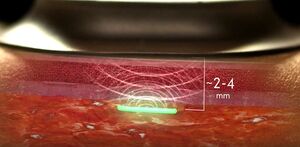Difference between revisions of "Nanotechnology"
m (hydrogels) |
m (adding references) |
||
| Line 12: | Line 12: | ||
==Biochip== | ==Biochip== | ||
| − | '''[[Hydrogels]]''' are a product of the | + | [[image:Hydrogels.jpg|thumb|The biosensors work fully integrated within the body’s tissue — without any metal device or electronics, thereby overcoming 'the foreign body response', the body’s attempts to reject it. ]] |
| + | '''[[Hydrogels]]''' are a product of the In Vivo Nanoplatforms (IVN) program that [[DARPA]]’s Biological Technologies Office (BTO) launched in [[2014]] to develop implantable nanotechnologies. <ref name=defense>https://www.defenseone.com/technology/2020/03/military-funded-biosensor-could-be-future-pandemic-detection/163497/</ref> | ||
| − | The company [[Profusa]] is developing a nanoscale | + | The company [[Profusa]]<ref>https://profusa.com/our-vision/</ref> is developing a nanoscale biosensor less than the size of a grain of rice, made of hydrogels that can detect symptoms of an infection. Rather than being isolated from the body, the biosensors work fully integrated within the body’s tissue — without any metal device or electronics, thereby overcoming 'the foreign body response', the body’s attempts to reject it. |
| − | This hydrogel includes a specially engineered [[molecule]] that sends a fluorescent signal outside the body when it begins to fight infection. This signal can then be detected by a sensor attached to the skin that can then be sent to an app or [[digital healthcare|even to a doctor’s website]]. | + | This hydrogel includes a specially engineered [[molecule]] that sends a fluorescent signal outside the body when it begins to fight infection. This signal can then be detected by a sensor attached to the skin that can then be sent to an app or [[digital healthcare|even to a doctor’s website]].<ref>https://nanotechnology.news/2020-10-12-darpa-funded-implantable-biochip-deploy-moderna-vaccine.html</ref> |
| − | When it was first tested in [[2018]], this hydrogel was being used to measure glucose, oxygen and lactate levels. However, in March 2020, the company announced | + | When it was first tested in [[2018]], this hydrogel was being used to measure glucose, oxygen and lactate levels. However, in March 2020, the company announced that it was conducting a study to see if the technology could be used to detect respiratory diseases, including [[COVID-19]]. <ref name=defense/> |
{{SMWDocs}} | {{SMWDocs}} | ||
Revision as of 02:51, 19 September 2021
(technology) | |
|---|---|
| Interest of | • Flemming Besenbacher • Ray Kurzweil • Charles Lieber • Metin Sitti |
Nanotechnology is technology created on the scale of individual atoms or molecules.
This is already creating new materials which are being mass produced and sold.
Contents
Nanoweapons
"The U.S., Russia and China are believed to be investing billions on nanoweapons research."[1]
Biochip
Hydrogels are a product of the In Vivo Nanoplatforms (IVN) program that DARPA’s Biological Technologies Office (BTO) launched in 2014 to develop implantable nanotechnologies. [2]
The company Profusa[3] is developing a nanoscale biosensor less than the size of a grain of rice, made of hydrogels that can detect symptoms of an infection. Rather than being isolated from the body, the biosensors work fully integrated within the body’s tissue — without any metal device or electronics, thereby overcoming 'the foreign body response', the body’s attempts to reject it.
This hydrogel includes a specially engineered molecule that sends a fluorescent signal outside the body when it begins to fight infection. This signal can then be detected by a sensor attached to the skin that can then be sent to an app or even to a doctor’s website.[4]
When it was first tested in 2018, this hydrogel was being used to measure glucose, oxygen and lactate levels. However, in March 2020, the company announced that it was conducting a study to see if the technology could be used to detect respiratory diseases, including COVID-19. [2]
An example
| Page name | Description |
|---|---|
| Lipid nanoparticle | First used in 2018, LNPs are now used in modified-RNA vaccines for SARS-CoV-2. |
References
- ↑ http://www.cnbc.com/2017/03/17/mini-nukes-and-inspect-bot-weapons-being-primed-for-future-warfare.html
- ↑ a b https://www.defenseone.com/technology/2020/03/military-funded-biosensor-could-be-future-pandemic-detection/163497/
- ↑ https://profusa.com/our-vision/
- ↑ https://nanotechnology.news/2020-10-12-darpa-funded-implantable-biochip-deploy-moderna-vaccine.html
